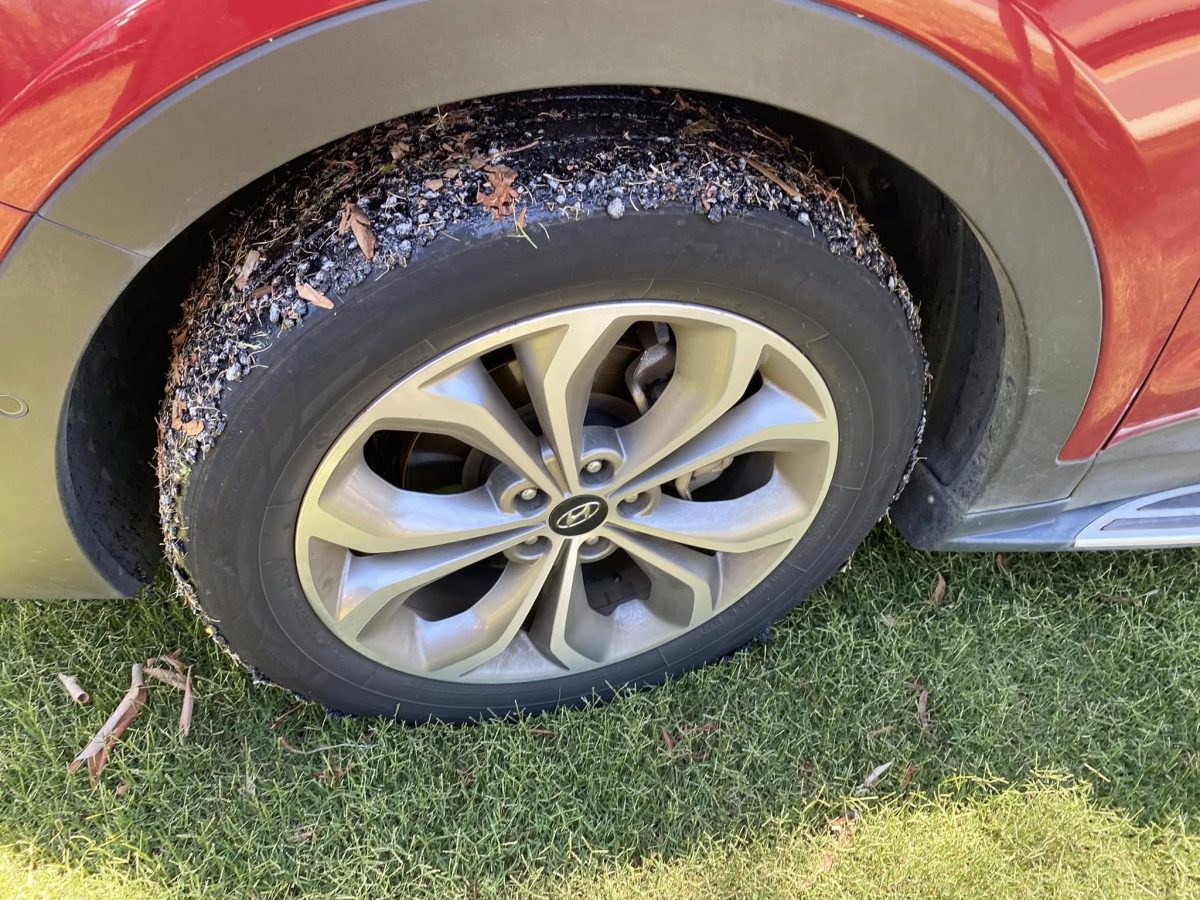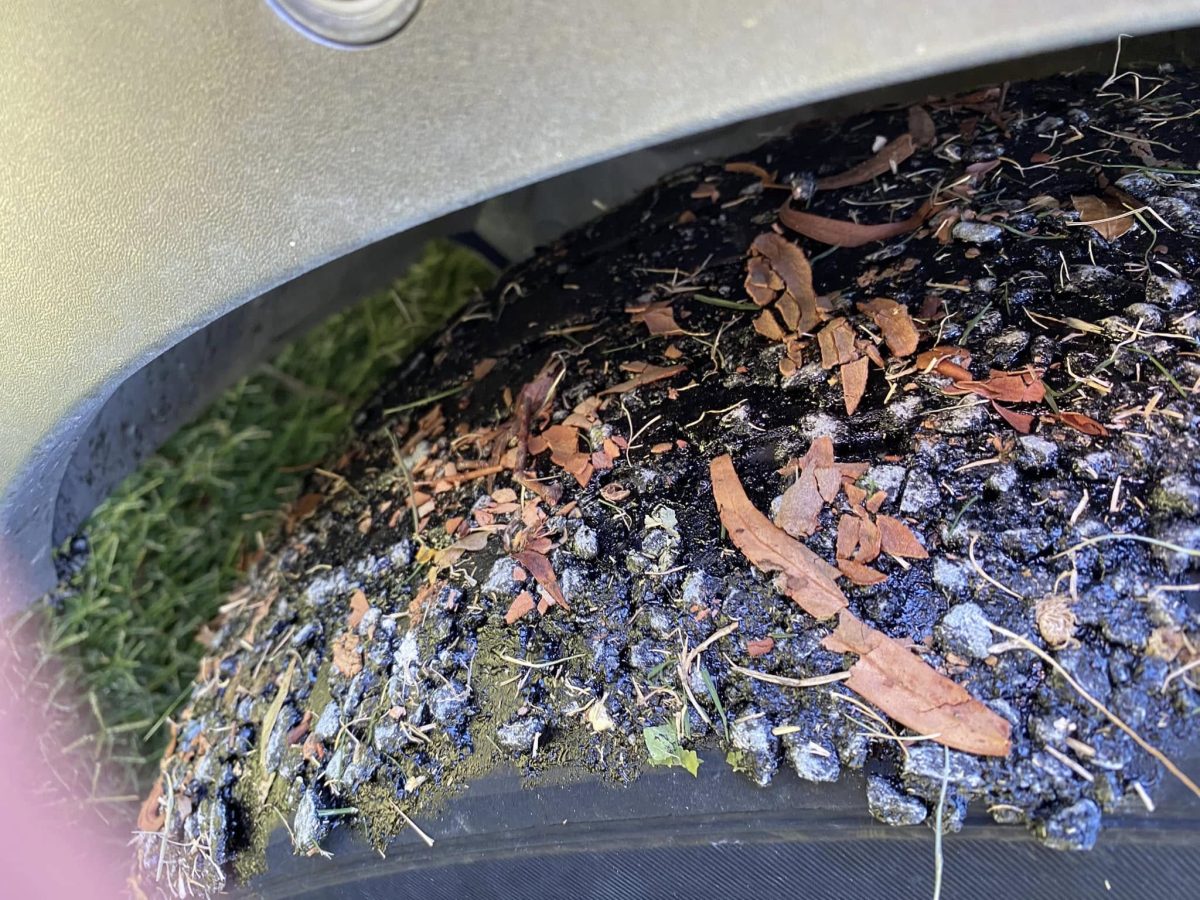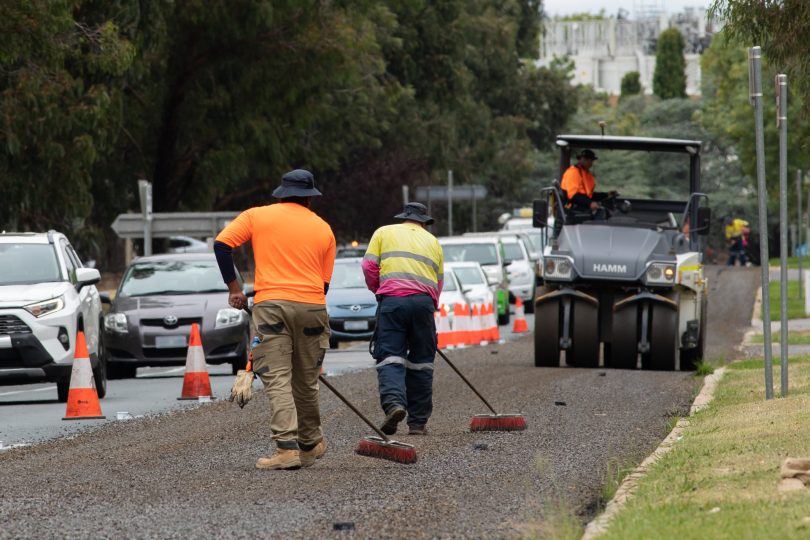
Bitumen from Drakeford Drive, Tuggeranong, stuck to a car’s tyre. Photo: Gaylene Butcher, Canberra Notice Board Group, Facebook.
For many Canberrans travelling home from work on Monday, the day’s heat had one final nasty card to play.
Several major roads across the ACT, including Drakeford Drive in Tuggeranong, Hindmarsh Drive in Woden and William Hovell Drive in Belconnen, turned to sticky mush on 16 December as temperatures soared to a high of 38 degrees Celsius.
“I drive carefully … on Drakeford Drive and … there was stuff stuck to my tyres,” one person posted to the Canberra Notice Board Group on Facebook.
“Tar and stones – both tyres on passenger side – now look like lamingtons. Also noticed small bits of tar on the car, too. Not happy, Jan!”
Commenters mentioned similar problems along Hindmarsh Drive between Fyshwick and Woden where the surface had “completely fallen apart”.
“Hindmarsh on Saturday was horrendous and they had three lanes down to one, flicking tar under everyone’s cars,” one read.
“It’s the same on William Hovell Drive going out to Belconnen, where the road has lifted, and now there’s loose chunks being thrown up by other cars,” said another.
One claimed to have been left with a $722 bill after two tyres on his car were “stuffed” after travelling on Drakeford Drive.
Others, however, said it was just part of life in an Australian summer.
“I remember 60 years ago, seeing the tar bubbling up out of the road on hot days and poking the bubbles with sticks,” one comment read.
“It’s bloody hot and the roads are melting. Always happens and has been happening for at least 40 years. Drive to the road conditions!”
Others wondered if an inferior quality of bitumen might be to blame.

Where we’re going, there are no roads. Photo: Gaylene Butcher, Canberra Notice Board Group, Facebook.
In response to questions from Region, the ACT Government said it had received reports through the online ‘Fix My Street’ portal on all three roads and is “working with contractors to address the issues”.
The spokesperson said the damage is “due to extreme heat” and not any “changes in road resurfacing materials”.
National Transport Research Organisation (NTRO) CEO Michael Caltabiano told Region the phenomenon is colloquially known as a “fatty seal”, or a “flushed seal”.
He explained that bitumen is sprayed onto the roads at a searingly hot temperature of 180 degrees when it’s a liquid before a layer of stones is placed on top. As the bitumen cools, the stones are stuck in place.
But a mistake at any point in this can lead to the stones sinking through the bitumen, and the bitumen, in turn, sticking to tyres.
“The engineering around getting the thickness of that liquid bitumen right is really quite complex,” he said
“And what happens when you get it wrong is what you see on that road in Tuggeranong, where you’ve got excess bitumen, or your stone isn’t the right size, or you’ve over-sprayed on existing bitumen. There’s a whole suite of potential problems.”
Fixing it isn’t as simple as laying down more stones either.
“You’ve either got to run some heaters over the road to reactivate the bitumen, before laying some more stone, or you have to seal again with a very, very light spray of bitumen, just enough to get the stone adhering again, or a bigger stone.”

Making roads is an art. Photo: Michelle Kroll.
Mr Caltabiano said the issue is becoming more common too.
“Nationally, we’re losing the skills of laying spray seals. Traditionally, the government would train its employees in the art, but they’ve sort of vacated the field and left it to the contractors, and it’s becoming more hit and miss than it ever has been in the past.”
He recounted a particularly bad case in Cairns about three years ago when around 10 km of road effectively “unravelled” on car and truck tyres.
“It was an absolute disaster.”
He said removing bitumen from paintwork and tyres is “a really, really difficult exercise”, but anti-greasing agents like kerosene show the most success.
The ACT Government told Region it is “not automatically liable for damage caused to vehicles” on our roads, and that each claim will be assessed on a “case-by-case basis”.
However, in recent years, the government has paid out tens of thousands of dollars in claims to motorists for damage caused by potholes, so there are success stories.
Visit City Services to lodge a claim.












